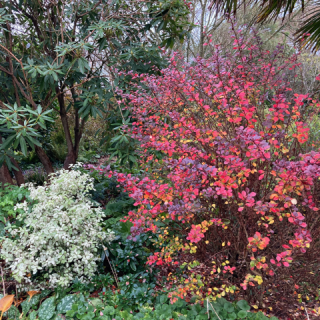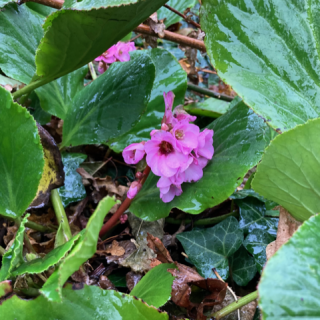“It is enough
To smell, to crumble the dark earth
While the robin sings over again,
Sad songs of autumn mirth ”
Edward Thomas “Digging”
October has been remarkably mild although we have had the precursor to November – the autumn storm. Although not such a bad thing that we have not needed to put the heating on so early in the year, but it generally does the garden and the wildlife good to at least have a little bit of ‘proper’ winter. It re-sets the clock for plants, puts some into dormancy and encourages others into the next step of their year. It also helps to control pests and diseases, especially those that have taken too much advantage of the hot summer.

Trees and shrubs
Ensure that trees and shrubs are prepared for the likely battering they will get from the storms this winter. Prune any roses with long stems to avoid wind rock which will damage the roots. Stake any trees or shrubs that are fragile, planted this year, or could just do with a bit of extra support.
If you’ve ordered bare-rooted roses and shrubs for planting, they should start to be delivered from November. You can plant them now, as soon as you get them. If you can’t, make sure they are heeled in to some soil in a spare corner, or at the very least placed in a large pot with compost.
To plant, place the roots in a bucket of water for an hour or two. Dig a hole plenty large enough to accommodate the roots, mix in a bit of compost with the soil you removed from the hole, but not too much. Add a handful of chicken manure pellets. Sprinkle a little mycorrhizal powder over the roots.
Depending on the shape of the roots, place some soil back on to the hole in a cone shape and fan the roots out over the top. Or if the plant has just one main root, place in the hole and get someone to hold the plant in the correct position while you thoroughly work the soil back in to the hole and around all the roots. It should be fairly clear where the soil level was on the roots before the plant was lifted.
Firm in (not too firm!) with a heel and water well. Mulch thickly, but don’t let the mulch touch the stem.

Pot-grown shrubs can be planted at any time, and it’s always worth a browse at the garden centre for plants that look great now – pyracantha and cotoneaster covered in berries, liriope muscari with its spires of purple, or a jewel-bearing crab apple.
Usually the advice is to start pruning deciduous trees and shrubs in November, but I find it can be so warm in Cornwall that they don’t fully lose their leaves until December. Usually I would leave this until Christmas and January, but if you have large trees or shrubs that might get damaged by the wind, then there is no problem with pruning them now.
You can take hardwood cuttings too. Cut sections of newer growth, preferably this year’s, into sections about 20cm long with at least one node at the top end and one at the bottom. It’s a good idea to mark which way is up by cutting one end straight across and the other at a slant so you don’t replant them upside down! Push them two thirds of the way into some gritty compost, or straight in to the soil, and leave for a year. Next summer they should produce leaves and new shoots.
There have been a couple of memes on social media about not raking up fallen leaves this year. While this does have plenty of merit, they will need removing from lawns and low growing plants that will otherwise be smothered and die.
I often leave fallen leaves on borders where they don’t cause any harm, and put about an inch of mulch right over the top of them. You get the benefit of the leaves but the mulch still makes the border look smart, and dark so that it warms up more quickly in the spring sun.

Herbaceous borders
Tulip planting time! It is tiresome that tulips don’t often last from year to year, and expensive to buy them each time, but I have to admit they put on such a bright, colourful and uplifting display that it is hard to resist. This year however, I have vowed not to buy any more but to wait and see how many come back. There are some in the garden that do persist, but only three or four types that are truly reliable. (My vow usually only lasts until the autumn bulb sales start).
If your borders are lacking somewhat in winter colour, there will be plenty of options at the garden centre. Traditional multicoloured pansies, hellebores in ever increasing new and beautiful forms with marbled leaves, or winter flowering heathers. I think there is a slow and quiet resurgence of the latter. Go for just one or two varieties of heather and slot them in amongst your herbaceous border for some extra colour.
Also can be used in pots for a bit of colour on the patio or by the door with evergreens like ivy, or even a small Callicarpa with its metallic purple berries.
If it’s still mild, it could be worth risking lifting and dividing hardy perennials if they are in a well-drained spot. Anything in a frost pocket or damp border, leave now until March.
Sternbergia lutea and autumn crocus are stars of the autumn border but unless you can find them potted up now, you do need to remember to order the bulbs in July!


The productive garden
Autumn and winter is such a productive time in the veg patch. Sprouts, cabbages, carrots, caulis, artichokes, kale, leeks, parsnips and spinach could all be ready for harvest in November.
Hardy broad beans and peas can be sown now (but not if your veg patch is likely to be blasted by salty winds, they don’t like it!). They can be covered with a cloche for a little extra help. Put nets over brassicas unless you want to share your Christmas vegetables with peckish pigeons.
Clean up the last of the summer produce if you haven’t already and put on the compost heap. Cover empty beds with a thick, fresh mulch of well-rotted manure compost so the rain and the worms can start to work it in ready for next spring.
Prune autumn-fruiting raspberries and mulch well around the roots, but try not to cover the stems.
Wash down the windows of your greenhouse to let in as much light as possible. It’s a good time to disinfect to make sure no crawlies have decided to overwinter in there, ready to pounce on your young crops next year! Wash your pots and trays and store away so they’re ready to be used in early spring.
And after all the plants have been prepared for winter, check fences, trellises, sheds and pergolas to see if they need repairs to survive any incoming storms too. November is a very busy month in the garden.
Caroline Kenzie

